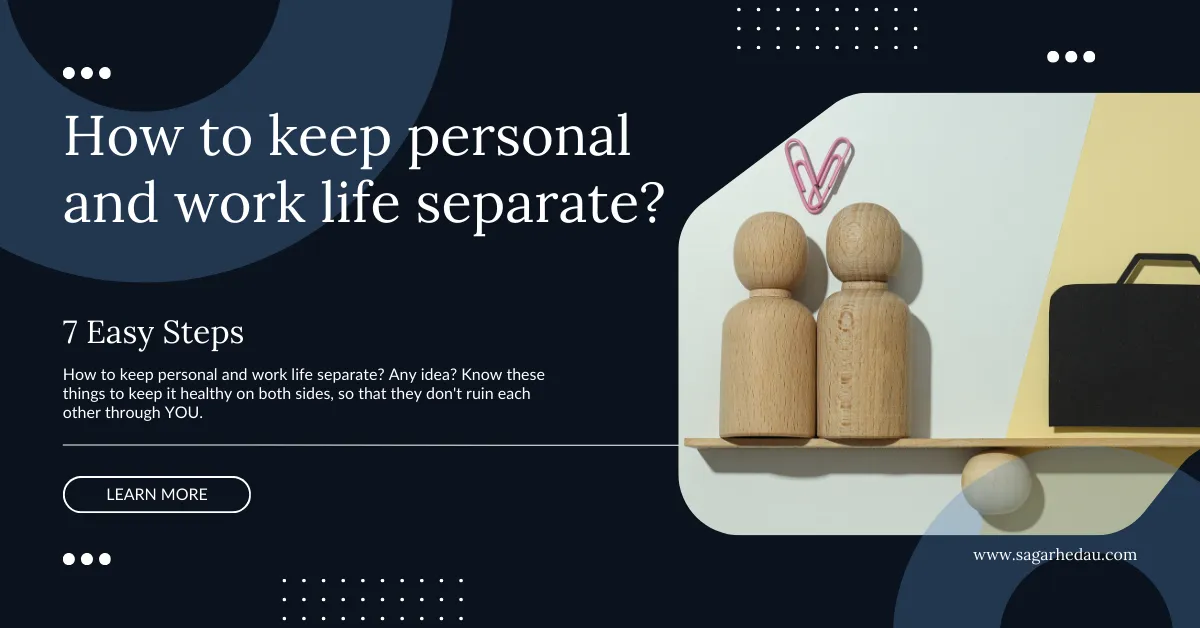In today’s fast-paced world, work-life balance has become a critical aspect of overall well-being and personal satisfaction. Maintaining a healthy equilibrium between professional responsibilities and personal life contributes to reduced stress, improved mental health, and increased productivity. It allows individuals to nurture relationships, pursue hobbies, and recharge, ultimately leading to better performance at work.
However, the digital age presents unique challenges to this balance. With smartphones and constant connectivity, work can easily spill into personal time. Remote work arrangements, while offering flexibility, often blur the lines between office and home.
Social media and email notifications create a sense of always being “on call.” These factors make it increasingly difficult to disconnect from work and fully engage in personal life, highlighting the need for intentional strategies to maintain separation in our interconnected world.
So, “how to keep personal and work life separate?”. Let’s learn something useful here.
How to keep personal and work life separate?
Maintaining a healthy separation between work and personal life is crucial for overall well-being and long-term success. We’ve explored several key strategies to achieve this balance:
- Setting clear boundaries by establishing work hours and creating dedicated workspaces
- Developing consistent routines for starting and ending the workday
- Learning to prioritize tasks and manage time effectively
- Actively disconnecting from work during personal time
- Communicating expectations clearly with colleagues and clients
- Practicing regular self-care to maintain physical and mental health
- Regularly reassessing and adjusting your approach to work-life balance
These strategies work together to create a framework for a more balanced life, allowing you to be productive at work while still enjoying and nurturing your personal life.
Setting clear boundaries
Setting clear boundaries is fundamental to maintaining a healthy work-life balance. Here’s how to implement this effectively:
A. Establish work hours: Define specific start and end times for your workday and stick to them consistently. Communicate these hours to colleagues, clients, and family members. This helps create a predictable routine and sets expectations for when you’re available for work-related matters.
B. Create a dedicated workspace: Designate a specific area in your home solely for work, even if it’s just a corner of a room. This physical separation helps your brain associate that space with work mode, making it easier to focus during work hours and disconnect when you leave that area. Ensure this space is comfortable and well-equipped to minimize distractions.
C. Use separate devices or accounts: If possible, use different devices for work and personal activities. This could mean having a work phone and a personal phone, or a work laptop and a personal tablet. If separate devices aren’t feasible, create distinct user profiles or accounts on your devices. This separation prevents work notifications from interrupting your personal time and helps maintain a clear divide between professional and personal digital spaces.
Develop a consistent routine
Developing a consistent routine is crucial for maintaining a clear separation between work and personal life. Here’s how to implement effective routines:
A. Create a morning routine: Start your day with activities that prepare you mentally and physically for work. This could include exercise, meditation, journaling, or enjoying a quiet breakfast. A consistent morning routine helps signal to your brain that it’s time to transition into work mode, increasing focus and productivity when you begin your workday.
B. Design an end-of-workday ritual: Establish a routine to mark the end of your work hours. This might involve tidying your workspace, creating a to-do list for the next day, or taking a short walk. These activities provide closure to your workday and help you mentally transition into personal time, making it easier to leave work behind.
C. Plan regular breaks throughout the day: Schedule short breaks during your workday to avoid burnout and maintain productivity. Use these breaks to step away from your work environment, stretch, practice deep breathing, or engage in a brief personal activity. Regular breaks help refresh your mind, reduce stress, and improve overall work efficiency, while also providing mini-transitions that reinforce the separation between work and personal time.
Learn to Prioritize
Effective prioritization is key to maintaining a healthy work-life balance:
A. Use time management techniques: Implement strategies like the Eisenhower Matrix to categorize tasks by urgency and importance, or the Pomodoro Technique to work in focused intervals. These methods help you tackle your workload efficiently, reducing the likelihood of work spilling into personal time.
B. Focus on important tasks during peak productivity hours: Identify your most productive hours and schedule your most challenging or important tasks during this time. This maximizes your efficiency and helps ensure critical work is completed within your designated work hours.
C. Learn to say “no” to non-essential commitments: Be selective about the tasks and projects you take on. Politely decline requests that don’t align with your priorities or would overextend you. This skill helps prevent work from overwhelming your personal life and allows you to focus on what truly matters.
Disconnect After Work
Actively disconnecting from work is crucial for maintaining work-life separation:
A. Turn off work notifications outside of work hours: Disable email, messaging, and other work-related notifications on your devices once your workday ends. This simple act can significantly reduce stress and prevent work from invading your personal space.
B. Avoid checking work emails during personal time: Resist the urge to check work communications during evenings, weekends, or vacations unless absolutely necessary. If you must check, set specific, limited times to do so rather than constantly monitoring.
C. Engage in hobbies and personal interests: Fill your personal time with activities you enjoy. Whether it’s reading, exercising, cooking, or spending time with loved ones, engaging in non-work activities helps you mentally distance yourself from work and recharge. This not only improves your personal life but also helps you return to work more refreshed and productive.
Communicate Your Expectations Clearly
Effective communication is crucial for maintaining work-life boundaries:
A. Inform colleagues and clients of your availability: Clearly communicate your working hours and response times. Use out-of-office messages and calendar settings to indicate when you’re unavailable. This helps manage others’ expectations and reduces the pressure to be constantly available.
B. Set realistic deadlines and manage expectations: Be honest about how long tasks will take and avoid over-promising. This prevents work from encroaching on your personal time due to unrealistic deadlines. If you’re overloaded, communicate this to your supervisor or team to find solutions.
C. Encourage open dialogue about work-life balance: Foster a team culture where discussing work-life balance is encouraged. This can lead to more supportive work environments and collaborative solutions for maintaining healthy boundaries.
Practice Self-Care on Top Priority
Self-care is essential for maintaining work-life balance:
A. Prioritize physical health: Make time for regular exercise, maintain a balanced diet, and ensure you get adequate sleep. These fundamentals form the foundation of your overall well-being and stress management capacity.
B. Maintain social connections: Nurture relationships outside of work. Regular interactions with family and friends provide emotional support and a sense of fulfillment that work alone can’t provide.
C. Engage in stress-reducing activities: Incorporate activities like meditation, yoga, or hobbies that help you relax and unwind. These practices can significantly reduce stress and improve your ability to handle work pressures.
Reassess Things and Adjust Regularly
Maintaining work-life balance is an ongoing process:
A. Evaluate your work-life balance periodically: Set aside time regularly to reflect on how well you’re managing the separation between work and personal life. Identify areas that need improvement and consider what’s working well.
B. Be flexible and willing to make changes: As your work or personal circumstances change, be prepared to adjust your strategies. What works in one phase of your career or life might not work in another.
C. Seek feedback from family and friends: Ask those close to you how they perceive your work-life balance. Their perspectives can provide valuable insights you might have overlooked and help you make necessary adjustments.
What if you don’t do this?
Not maintaining a separation between personal and work life can lead to several negative consequences. Here are some examples:
- Burnout: Constantly checking work emails during family time leads to mental exhaustion and a feeling of never truly being off work.
- Decreased productivity: Mixing personal tasks with work tasks throughout the day results in neither being done efficiently, leading to longer work hours and less free time.
- Strained relationships: Repeatedly cancelling plans with friends or family due to work commitments can damage personal relationships and lead to feelings of isolation.
- Health issues: Neglecting personal time for exercise and proper meals due to work overflow can lead to physical health problems like weight gain or increased stress levels.
- Loss of personal identity: Defining oneself solely by work achievements can lead to a crisis of identity when faced with job changes or retirement.
- Increased stress: The constant feeling of being “on call” for work, even during vacations, can lead to chronic stress and anxiety.
- Reduced job satisfaction: Allowing work to consume personal time can lead to resentment towards the job, even if it was once enjoyable.
- Impaired sleep: Answering work emails late into the night can disrupt sleep patterns, leading to fatigue and decreased overall performance.
- Missed life experiences: Consistently prioritizing work over personal events can result in missing important family milestones or personal growth opportunities.
- Diminished creativity: Lack of downtime and diverse experiences outside of work can lead to reduced creativity and problem-solving abilities in professional tasks.
These negative consequences highlight the importance of maintaining a healthy separation between work and personal life.
Conclusion
So, how to keep personal and work life separate? To do this, it’s important to recognize that achieving work-life balance is not a one-time task, but an ongoing process that requires constant attention and adjustment. As your career evolves, family circumstances change, or new challenges arise, you may need to revisit and modify your approach. Stay mindful of your needs and be willing to make changes when necessary.
Remember that perfect balance is rarely achievable all the time, and it’s okay to have periods where one area of your life may require more focus. The key is to strive for overall balance in the long term, making conscious choices to prioritize both your professional goals and personal well-being.
By consistently applying these strategies and remaining flexible, you can create a fulfilling life that honours both your career ambitions and personal needs.


